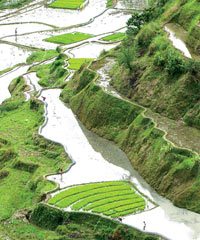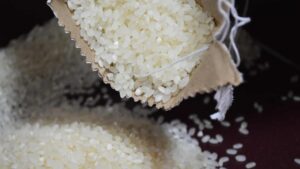
An in-depth overview of the global seed industry. From wheat polyploid hybrids in France to a successful seed project in West Africa.
STATUS PHILIPPINES
Despite dreadful flooding around Manila and other major rice-growing regions in the Philippines this summer, there is hope for growers in the region in the form of flood-resistant Submarino rice varieties.
Bred by the International Rice Research Institute, varieties in this category can survive being under water for two weeks if floods occur before flowering. According to the IRRI, the latest Submarino variety, Submarino1 (NSIC RC194) was released in the Philippines in 2009, joining Sacobia (PSB RC68), released in 1997. Submarino1 has been disseminated and promoted by the Philippine Department of Agriculture and the Philippine Rice Research Institute.
According to the IRRI, Submarino varieties (or Scuba varieties, as they are sometimes referred to internationally) work because they contain a gene called sub1, which allows it to conserve energy and remain in a dormant state until floodwaters recede.
Submarino varieties have been widely adopted by Philippine growers, and this improves their odds of weathering the summer’s storms, according to V. Bruce J. Tolentino, IRRI deputy director general for communications and partnerships. “By planting Submarino rice, farmers have a fighting chance to outlast most rains and floods that unfortunately beset the country,” said Tolentino.
IRRI’s scuba rice has also been introduced to India and Bangladesh. Submarino is a localized variety in the Philippines; in India, the sub1 gene has been added into their own local variety called Swarna and is called Swarna-sub1. Samba Mahsuri is another Indian variety with the sub1 gene. Certain varieties in Bangladesh also contain the gene.
STATUS CHINA
According to researchers at Fudan University and the Fujian Academy of Agricultural Sciences, the spread of genes from cultivated genetically engineered crops into nearby wild species is inevitable but may not happen as quickly as expected.
In their study, the researchers crossed a rice strain that had been genetically engineered to carry an insect-resistant gene with a wild rice variety. Four generations later, they tested the “offspring” in test plots in Fuzhou, in Fujian Province, China, comparing survival rates of progeny containing the insect-resistant transgene against those without the transgene. They also compared the original wild rice plant’s survival rates under high and low insect pest conditions.
In their study published in July, entitled “Limited Fitness Advantages of Crop-Weed Hybrid Progeny Containing Insect-Resistant Transgenes (Bt/ CpTI) in Transgenic Rice Field,” the researchers write, “given that the extensive cultivation of an insect-resistant GE crop will ultimately reduce the target insect pressure, the rapid spread of insect-resistance transgenes in weedy populations in commercial GE crop fields may be not likely to happen.”
Despite their findings, Xue Dayuan, chief biodiversity scientist at the College of Life and Environmental Sciences at the Minzu University of China, told SciDev.Net that the field tests were limited in what they can show. “It’s totally different with the open field. Under the different climate and ecological environments, the risk from the potential transgene flow or transgene pollution may be more likely to happen,” Xue was quoted as saying in the SciDev.Net article.
STATUS DRC
The International Institute of Tropical Agriculture has inaugurated its Central African hub with the commissioning of a building in Kinshasa that will cover the west provinces and an office in Bukavu, in South-Kivu, that will serve the entire Great Lakes subregion of the Democratic Republic of Congo. According to the IITA, the hub concept aims to accelerate the institute’s response to the different opportunities and threats to food security in sub-Saharan Africa.
In a press release, the IITA’s director general, Nteranya Sanginga, said the decision to locate the hub in the DRC “is important because of the country’s agricultural potential, which serves as a focal point for research for countries of the Central African region.” Sanginga sees the inauguration of the building in Kinshasa as part of the institute’s strategy for efficient delivery of research outputs.
In Central Africa, IITA will work with national agricultural research systems such as the Institut National pour l’Etude et la Recherche Agronomique, universities, non-governmental organizations, farmers and the private sector. Sanginga said that the establishment of the hub would also consolidate the long-time collaboration between IITA and partners in that region.
The Central African hub is the fourth established by the institute. The East African hub has its operations in Tanzania, the Southern African hub in Lusaka, Zambia, and the West African hub is based in Nigeria.
STATUS PARAGUAY
Following Argentina’s announcement that Roundup Ready 2 approvals are forthcoming, Paraguay has announced that it plans to approve Monsanto’s Roundup Ready 2 soybean technology, along with new corn technology, before the end of the year.
“With this step we will improve the technology balance between ourselves and other countries, improving our ability to compete,” the head of trade for Paraguay’s Agriculture Ministry, Santiago Bertoni, told Reuters, adding that approvals should come in time for planting in October. “The 2013 harvest will include fields planted with these seeds.”
Bertoni said that Paraguay also aims to approve corn technology from Monsanto and Dow AgroSciences in the near future.
Due to drought during the 2011/12 season, soybean yields in Paraguay were reduced to 4.3 million metric tonnes. But the country expects to increase its soy output in 2012/13 to 8 million metric tonnes with the use of the new Monsanto varieties.
The announcement comes amidst fears of genetic cross-contamination by some Paraguayan groups concerned about potential environmental and health hazards of GM technology. But Paraguay seeks to expand its soy output to meet increasing demand and position itself as a top grains exporter.
Currently, Paraguay comes fourth in global soybean exports, after the United States, Brazil and Argentina.














